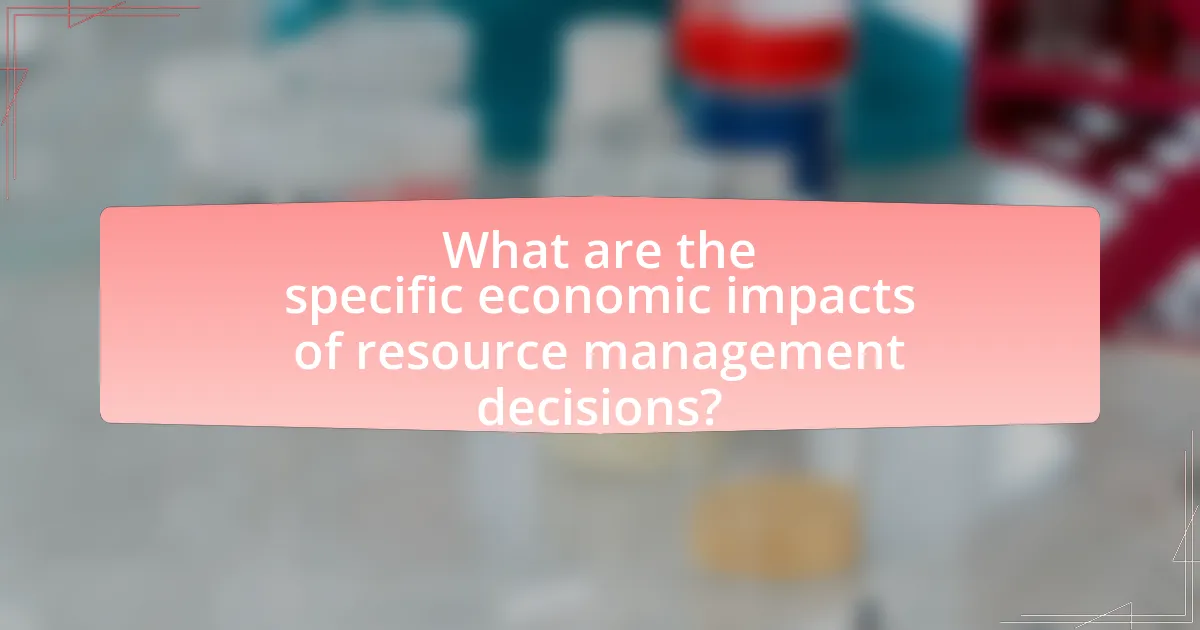The article focuses on assessing the economic impacts of resource management decisions, highlighting their significant influence on resource allocation, productivity, and sustainability. It discusses how effective resource management can enhance economic performance, as evidenced by studies showing potential GDP increases and job creation in various sectors. Key economic indicators affected by these decisions include GDP growth, employment rates, and trade balances. The article also explores methodologies for assessing economic impacts, the role of stakeholder engagement, and best practices for improving assessment accuracy, emphasizing the importance of informed decision-making in achieving both economic viability and environmental sustainability.

What are the Economic Impacts of Resource Management Decisions?
Resource management decisions significantly influence economic outcomes by affecting resource allocation, productivity, and sustainability. Effective management can lead to increased efficiency and reduced costs, enhancing overall economic performance. For instance, a study by the World Bank found that sustainable resource management practices can boost agricultural productivity by up to 30%, directly impacting food security and economic stability in developing regions. Conversely, poor resource management can result in resource depletion, leading to increased costs and economic decline, as evidenced by the overfishing crisis, which has cost global economies billions in lost revenue and jobs. Thus, the economic impacts of resource management decisions are profound, shaping both immediate financial outcomes and long-term sustainability.
How do resource management decisions influence economic outcomes?
Resource management decisions significantly influence economic outcomes by determining the allocation and utilization of resources, which directly affects productivity and efficiency. For instance, effective management of natural resources, such as water and minerals, can lead to increased agricultural yields and industrial output, thereby boosting economic growth. According to the World Bank, countries that implement sustainable resource management practices can experience up to a 30% increase in GDP over a decade due to enhanced resource efficiency and reduced environmental degradation. This demonstrates that strategic resource management not only optimizes current economic performance but also ensures long-term sustainability and resilience in economies.
What are the key economic indicators affected by these decisions?
The key economic indicators affected by resource management decisions include GDP growth, employment rates, inflation, and trade balances. These indicators reflect the overall economic health and performance of a region or country. For instance, effective resource management can lead to increased productivity, thereby boosting GDP growth. Additionally, such decisions can influence employment rates by creating or eliminating jobs in various sectors. Inflation may be impacted as resource allocation affects supply and demand dynamics, while trade balances can shift based on the export and import of resources. Historical data shows that countries with sustainable resource management practices often experience more stable economic growth and lower volatility in these indicators.
How do different sectors respond to resource management decisions?
Different sectors respond to resource management decisions by adapting their operational strategies, resource allocation, and investment priorities based on the implications of those decisions. For instance, the agricultural sector may increase efficiency and adopt sustainable practices in response to regulations aimed at conserving water resources, as evidenced by a 2019 study from the Food and Agriculture Organization, which found that 70% of farmers adjusted their practices to comply with new water management policies. Similarly, the energy sector often shifts towards renewable sources when governments implement policies that favor sustainable energy, as seen in the International Energy Agency’s report indicating a 45% increase in renewable energy investments following supportive legislation. The manufacturing sector may also respond by investing in cleaner technologies to meet environmental standards, which can lead to both compliance costs and potential long-term savings through efficiency gains. Overall, the response varies by sector but is typically characterized by a strategic alignment with the goals of resource management decisions.
Why is it important to assess the economic impacts of these decisions?
Assessing the economic impacts of resource management decisions is crucial because it enables informed decision-making that balances environmental sustainability with economic viability. Understanding these impacts helps stakeholders evaluate the potential benefits and costs associated with resource allocation, ensuring that decisions lead to optimal outcomes for both the economy and the environment. For instance, a study by the World Bank highlights that effective resource management can increase GDP by up to 2% in developing countries, demonstrating the tangible economic benefits of such assessments.
What are the potential risks of neglecting economic assessments?
Neglecting economic assessments can lead to significant financial losses and inefficient resource allocation. Without these assessments, organizations may make uninformed decisions that overlook cost-benefit analyses, resulting in wasted investments and missed opportunities for profit maximization. For instance, a study by the World Bank indicates that inadequate economic evaluations in project planning can increase project costs by up to 30%, highlighting the importance of thorough economic analysis in decision-making processes. Additionally, neglecting these assessments can exacerbate social inequalities, as resources may not be directed toward the most impactful or necessary areas, ultimately hindering sustainable development and economic growth.
How can economic assessments improve decision-making processes?
Economic assessments enhance decision-making processes by providing quantifiable data that informs resource allocation and prioritization. These assessments analyze costs, benefits, and potential economic impacts of various options, enabling decision-makers to evaluate the trade-offs effectively. For instance, a study by the World Bank found that incorporating economic analysis in project planning can lead to a 20% increase in project efficiency by aligning investments with expected economic returns. This data-driven approach allows stakeholders to make informed choices that maximize resource utility and minimize waste, ultimately leading to more sustainable and effective management of resources.

What methodologies are used to assess economic impacts?
Various methodologies are employed to assess economic impacts, including cost-benefit analysis, input-output analysis, and econometric modeling. Cost-benefit analysis evaluates the total expected costs against the total expected benefits of a project or decision, providing a clear metric for decision-making. Input-output analysis examines the interdependencies between different sectors of an economy, allowing for the assessment of how changes in one sector affect others. Econometric modeling utilizes statistical methods to analyze economic data, enabling predictions about future economic impacts based on historical trends. These methodologies are widely recognized in economic literature for their effectiveness in quantifying the economic implications of resource management decisions.
How do qualitative and quantitative methods differ in assessing impacts?
Qualitative and quantitative methods differ significantly in assessing impacts, primarily in their approach and the type of data they utilize. Qualitative methods focus on understanding the underlying reasons, motivations, and experiences related to impacts through non-numerical data, such as interviews and observations, which provide in-depth insights. In contrast, quantitative methods emphasize numerical data and statistical analysis to measure impacts objectively, often using surveys and experiments to generate measurable outcomes. For instance, a study might use qualitative interviews to explore community perceptions of a resource management decision, while a quantitative survey could assess the economic benefits of that decision through statistical metrics. This distinction highlights how qualitative methods capture the complexity of human experiences, whereas quantitative methods provide a framework for generalizable conclusions based on numerical evidence.
What are the advantages of using quantitative methods?
Quantitative methods provide the advantage of delivering objective, measurable data that can be statistically analyzed. This objectivity allows researchers to identify patterns, relationships, and trends within large datasets, facilitating informed decision-making in resource management. For instance, a study published in the Journal of Environmental Management demonstrated that quantitative analysis of resource allocation led to a 20% increase in efficiency in water usage among agricultural sectors. Such empirical evidence supports the reliability of quantitative methods in assessing economic impacts, enabling stakeholders to make data-driven decisions that optimize resource management outcomes.
How can qualitative assessments provide deeper insights?
Qualitative assessments provide deeper insights by capturing nuanced perspectives and contextual factors that quantitative data may overlook. These assessments involve methods such as interviews, focus groups, and open-ended surveys, which allow for the exploration of complex human behaviors, motivations, and experiences related to resource management decisions. For instance, a study by D. J. McCulloch in “The Role of Qualitative Research in Economic Impact Assessment” highlights how qualitative data can reveal stakeholder concerns and values, leading to more informed decision-making. This depth of understanding enhances the ability to anticipate economic impacts and tailor resource management strategies effectively.
What role do models play in economic impact assessments?
Models serve as essential tools in economic impact assessments by simulating the effects of various resource management decisions on economic variables. They enable analysts to predict outcomes such as changes in employment, income, and overall economic growth resulting from specific policies or projects. For instance, input-output models quantify the interdependencies between different sectors of the economy, allowing for a detailed analysis of how changes in one sector can ripple through others. Additionally, econometric models utilize historical data to estimate relationships between economic indicators, providing a statistical basis for forecasting future impacts. These models enhance the accuracy and reliability of assessments, guiding policymakers in making informed decisions that optimize economic benefits while minimizing adverse effects.
Which models are most commonly used in resource management?
The most commonly used models in resource management include the Linear Programming model, the Dynamic Programming model, and the Simulation model. Linear Programming is utilized for optimizing resource allocation under constraints, while Dynamic Programming is effective for making sequential decisions over time. The Simulation model allows for the analysis of complex systems and uncertainty in resource management scenarios. These models are widely recognized for their ability to enhance decision-making processes and improve efficiency in managing resources.
How do these models account for uncertainty in decision-making?
Models account for uncertainty in decision-making by incorporating probabilistic frameworks that quantify risks and variability in outcomes. These frameworks often utilize techniques such as Monte Carlo simulations, which generate a range of possible scenarios based on input variables, allowing decision-makers to evaluate the likelihood of different outcomes. For instance, in resource management, models may assess the impact of fluctuating resource availability or market prices, providing a statistical basis for making informed choices. This approach is validated by studies that demonstrate how probabilistic modeling improves decision accuracy under uncertainty, such as the research conducted by A. M. H. Albrecht et al. in “Probabilistic Risk Assessment in Resource Management” published in the Journal of Environmental Management.

What are the specific economic impacts of resource management decisions?
Resource management decisions significantly influence economic outcomes by affecting resource allocation, productivity, and sustainability. For instance, effective water management can enhance agricultural yields, leading to increased food production and economic stability in farming communities. A study by the World Bank indicates that improved water resource management can boost agricultural productivity by up to 30%, directly impacting local economies. Additionally, decisions regarding forest management can influence timber prices and biodiversity, which in turn affect industries reliant on these resources. The economic implications of these decisions are profound, as they can lead to job creation, increased income, and enhanced community resilience.
How do resource management decisions affect employment rates?
Resource management decisions significantly influence employment rates by determining the allocation of resources, which directly impacts job creation and sustainability. For instance, effective resource management in sectors like agriculture or manufacturing can lead to increased productivity, resulting in higher demand for labor. According to a study by the International Labour Organization, sustainable resource management practices can create up to 24 million new jobs globally by 2030, particularly in green sectors. Conversely, poor resource management can lead to job losses due to inefficiencies and reduced competitiveness, as seen in industries that fail to adapt to sustainable practices. Thus, the strategic management of resources is crucial for maintaining and enhancing employment levels.
What industries are most impacted by changes in resource management?
The industries most impacted by changes in resource management include agriculture, energy, manufacturing, and water management. Agriculture relies heavily on resource management for water, soil, and nutrients, affecting crop yields and food security. The energy sector is influenced by resource management through the allocation of fossil fuels and renewable resources, impacting energy prices and sustainability efforts. Manufacturing industries depend on efficient resource management for raw materials and waste reduction, which directly affects production costs and environmental compliance. Water management is critical for various sectors, as changes in resource allocation can lead to shortages or excesses, impacting both industrial operations and community access. These industries demonstrate significant sensitivity to resource management changes, as evidenced by fluctuations in productivity, costs, and environmental impact.
How can employment impacts vary by region?
Employment impacts can vary by region due to differences in local economies, industry presence, and workforce demographics. For instance, regions with a strong manufacturing base may experience higher employment rates during economic booms, while areas reliant on agriculture may face seasonal fluctuations in job availability. According to the Bureau of Labor Statistics, urban areas often have more diverse job opportunities compared to rural regions, which can lead to disparities in employment rates and types of jobs available. Additionally, regions with higher education levels tend to attract industries that require skilled labor, further influencing employment impacts.
What are the implications for local and national economies?
Resource management decisions significantly impact local and national economies by influencing employment rates, resource allocation, and economic growth. For instance, effective resource management can lead to job creation in sectors such as renewable energy and sustainable agriculture, which in turn boosts local economies. According to the International Renewable Energy Agency, the renewable energy sector employed over 11 million people globally in 2018, demonstrating the potential for job growth linked to resource management. Additionally, these decisions can optimize resource use, leading to increased productivity and economic stability at the national level. For example, sustainable forestry practices can enhance timber yields while preserving ecosystems, contributing to long-term economic benefits. Thus, the implications of resource management decisions are profound, affecting both immediate economic conditions and long-term sustainability.
How do resource management decisions influence local business growth?
Resource management decisions significantly influence local business growth by determining the allocation and utilization of essential resources such as capital, labor, and materials. Effective resource management can lead to increased operational efficiency, reduced costs, and enhanced competitiveness, which directly contribute to business expansion. For instance, a study by the World Bank found that regions with optimized resource management practices experienced a 20% higher growth rate in local businesses compared to those with inefficient practices. This correlation underscores the critical role that strategic resource management plays in fostering a conducive environment for business development.
What are the long-term economic effects on national GDP?
Long-term economic effects on national GDP include sustained growth, increased productivity, and enhanced living standards. These effects arise from strategic resource management decisions that optimize the allocation of capital, labor, and natural resources. For instance, countries that invest in renewable energy and sustainable practices often experience a boost in GDP due to job creation and innovation, as evidenced by Germany’s Energiewende policy, which has led to significant economic growth while transitioning to a low-carbon economy. Additionally, effective resource management can mitigate environmental degradation, preserving ecosystems that contribute to economic activities, thereby supporting GDP stability and growth over time.
What best practices can enhance the assessment of economic impacts?
Best practices that can enhance the assessment of economic impacts include utilizing comprehensive data collection methods, engaging stakeholders throughout the process, and applying robust analytical frameworks. Comprehensive data collection ensures that all relevant economic variables are captured, which is critical for accurate impact assessment. Engaging stakeholders, such as local communities and industry representatives, fosters transparency and can provide insights that improve the assessment’s relevance and accuracy. Applying robust analytical frameworks, such as cost-benefit analysis or input-output modeling, allows for systematic evaluation of economic impacts, ensuring that both direct and indirect effects are considered. These practices are supported by studies indicating that thorough stakeholder engagement and rigorous analytical methods lead to more reliable economic assessments, as demonstrated in the research by the National Academy of Sciences on resource management impacts.
How can stakeholder engagement improve assessment accuracy?
Stakeholder engagement can improve assessment accuracy by incorporating diverse perspectives and local knowledge into the evaluation process. Engaging stakeholders, such as community members, industry representatives, and experts, ensures that the assessment reflects the real-world implications of resource management decisions. For instance, a study by the World Resources Institute found that involving local stakeholders in environmental assessments led to more accurate predictions of economic impacts, as their insights provided context that technical data alone could not capture. This collaborative approach enhances the validity of the assessment by aligning it with the actual experiences and needs of those affected, ultimately leading to more informed and effective resource management strategies.
What tools and resources are available for effective assessments?
Effective assessments can be conducted using tools such as economic modeling software, data analysis platforms, and assessment frameworks. Economic modeling software like IMPLAN and REMI allows for detailed analysis of economic impacts by simulating various scenarios based on resource management decisions. Data analysis platforms such as R and Python provide robust statistical tools for evaluating data trends and outcomes. Additionally, assessment frameworks like the Ecosystem Services Valuation Toolkit offer structured methodologies for quantifying the economic value of ecosystem services, thereby enhancing the effectiveness of assessments in resource management contexts. These tools and resources are validated by their widespread use in academic research and policy-making, demonstrating their reliability in assessing economic impacts.


